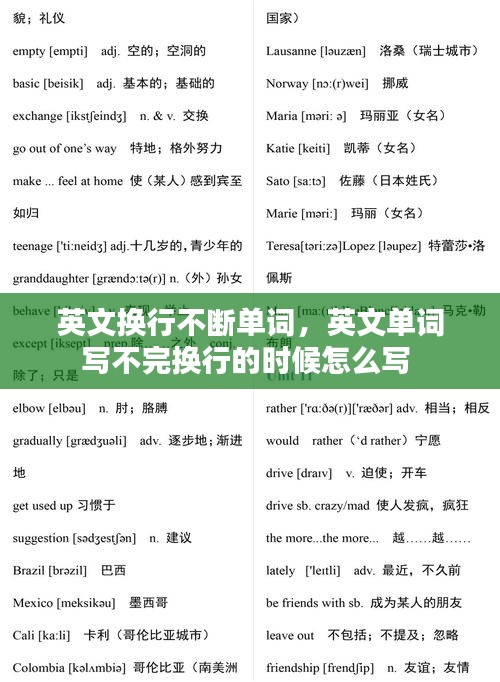Understanding the Concept of Hyphenation in English Writing
Writing in English often requires careful attention to the rules of grammar and punctuation. One such rule that can sometimes cause confusion is the handling of long words that may need to be split across lines. This is where the concept of hyphenation comes into play. Hyphenation is the process of breaking a word into two or more parts, usually by inserting a hyphen, to fit it within the line width of a paragraph. However, there are instances where a word may be too long to be hyphenated or may not require it, leading to a continuous flow of text without breaks. This article explores the reasons behind this phenomenon and provides guidance on how to handle it effectively.
Why Do We Need to Hyphenate Words?
Hyphenation is necessary in English writing for several reasons. Firstly, it helps to maintain the readability of the text. When a word is too long to fit on a single line, breaking it up can prevent the reader from having to strain their eyes or re-read the line to make sense of the word. Secondly, hyphenation can prevent awkward breaks that might disrupt the flow of the sentence. For example, consider the word "antidisestablishmentarianism." Without hyphenation, this word would be split into "anti-dis-establish-ment-a-rian-ism," which is not only difficult to read but also breaks the word into parts that may not be immediately recognizable as a single concept. Hyphenation, on the other hand, allows the word to be split into "anti-dis-establish-ment-arian-ism," which is more manageable and maintains the word's integrity.
When to Hyphenate and When Not to
While hyphenation is a useful tool, it is not always necessary. Here are some guidelines to help determine when to hyphenate a word and when not to:
Always hyphenate compound adjectives before a noun. For example, "well-known author" is correct, but "well known author" is not.
Hyphenate prefixes and suffixes that are not commonly used. For example, "self-esteem" is hyphenated, but "self-esteem" is not.
Hyphenate words that are hyphenated in a dictionary. For example, "re-sign" is hyphenated, but "sign" is not.
Do not hyphenate words that are not hyphenated in a dictionary. For example, "recommend" is not hyphenated, and neither is "recommendation."
Do not hyphenate words that are commonly used as single words. For example, "recommend" is not hyphenated, even though it is a long word.
However, there are exceptions to these rules. For instance, the word "unbelievable" is not hyphenated, despite being a long word, because it is a single word in common usage. Similarly, "self-esteem" is not hyphenated in most contexts, even though it is a compound word.
Continuous Flow of Text Without Hyphenation
In some cases, a word may be too long to be hyphenated and may not require it. This can happen with very long compound words or with words that are not commonly hyphenated. For example, the word "antidisestablishmentarianism" is not typically hyphenated, and it is acceptable to allow it to flow continuously across lines. Similarly, the word "unbelievably" may be allowed to flow without hyphenation, especially if it is followed by a comma or a period, which indicates a natural pause in the sentence.
It is important to note that the decision to allow a long word to flow continuously without hyphenation should be made with consideration for readability and the overall flow of the text. If the word is too long and breaks the natural rhythm of the sentence, it may be better to find an alternative way to express the idea or to break the word into two parts that can be hyphenated.
Hyphenation in Different Styles and Formats
The rules for hyphenation can vary depending on the style guide or format being used. For example, the APA style guide generally recommends hyphenating compound adjectives, while the MLA style guide does not. Similarly, different types of publications may have their own preferences regarding hyphenation. It is always a good idea to consult the specific style guide or publication manual for the most accurate and up-to-date information.
Conclusion
转载请注明来自深圳市鹏腾电子发展有限公司,本文标题:《英文换行不断单词,英文单词写不完换行的时候怎么写 》












 粤ICP备19130523号-1
粤ICP备19130523号-1
还没有评论,来说两句吧...